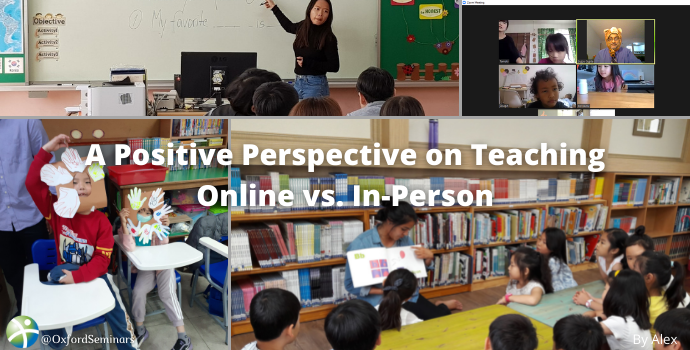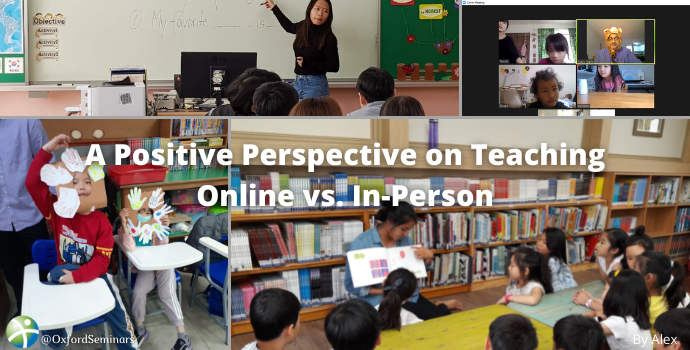
Let’s stay positive! Since the global pandemic has already given us more than enough tragic news over the past two years, I wanted to keep this blog uplifting by looking at some of the positive aspects of teaching both online and in-person classes. Aside from providing a small break from the rather pervasive negative news cycle, there’s also a more instructive reason for focusing on the bright side of whatever teaching environment you may find yourself in, and that is being goal oriented. Okay sure, that sounds obvious, but what am I really talking about? In this blog, I’ll try to give you my perspective on how staying positive and being goal oriented will lead to more effective lessons and a more rewarding work experience, regardless of whether you’re standing in front of a classroom full of students, or teaching one-on-one over Zoom.
Digital technologies have revolutionized the field of education globally, and the increasing international demand for online English classes is one offshoot of this revolution. Having instant access to English classes from anywhere in the world, at virtually any time of the day or night, from the comfort of your home or convenience of your office, is clearly a highly desirable alternative to in-person lessons. However, there’s also a natural impulse to ask ourselves the basic question: isn’t something lost? There seem to be a host of both tangible and intangible elements which give the in-person classroom environment a unique dynamic and energy, which presumably can’t be fully replicated in the virtual classroom.

I’ve mostly taught in-person, so my impulse would be to imagine that there is something magical that happens in a classroom full of students that could only happen in a classroom full of students. I’ve heard teachers tell stories about deciding in the moment to act out being a fish by getting down and flopping around wildly on the floor. I myself have done many rock and roll high kicks and air guitar solos for zero reason other than to grab attention and elicit some giggles from my helpless students. From running races to hurling soft objects, there are so many interactive language learning activities that become commonplace in the classroom. Even adult classes can get pretty silly at times. So, are any of these types of activities likely to occur in the same way in online classes? Could they? Should they?
I’ll leave it up to the readers to ponder the question of how much of the live interaction that goes on in a schoolroom can, or should, be replicated in online classes, and what other tools could be used when teaching online to compensate for, or recreate, the in-person teaching experience? Instead, I’d like to return to the idea of looking for the positives in both in-person and online teaching, and talk about setting realistic and achievable goals.
Teaching Goals
Creating successful and effective lesson plans can be a challenging task, especially for new teachers and for teachers who find themselves teaching in new and unfamiliar types of learning environments. For many of us, the online environment remains relatively novel, and presents unique challenges in terms of how to effectively engage students and create dynamic, interactive lessons. But whether you’re teaching in a new and unfamiliar environment, or a comfortable and familiar one, it’s important to set a clear and achievable learning objective, and one which can be reached efficiently using the learning materials at your disposal.

Focusing on the positive aspects of the learning environment you create for your students will help you to set clear, achievable lesson objectives. And while it may be impossible to fully recreate the experience of the in-person classroom environment in a digital space, that does not mean the digital classroom cannot be an equally effective learning environment. However, it’s up to us as teachers to set clearly defined lesson objectives that we are confident our students can achieve, given the positive teaching resources which we have at our disposal. Focusing on finding and learning to effectively use the resources which we do have access to – whether online or ‘in real life’ – is key. And I believe that keeping a positive attitude and focusing on the pros, rather than the cons, will help teachers create successful and engaging learning environments for themselves and their students, whether online or in-person.
Personal and Professional Goals
Whether personally or professionally, finding constructive ways to achieve your goals can be daunting, but searching for the positives rather than dwelling on the negatives is, in my eyes, both a good place to start, and a good guide to staying on the right track. Both the traditional classroom environment and the relatively new, digital classroom environment present unique challenges and rewards, and weighing the balance of these will inevitably be a very personal process for each of us. So, it would be ridiculous to try to generalize and say something like ‘everyone enjoys and prefers the comfort and convenience of working from home,’ or ‘online classes will never be as fun, dynamic and engaging as live, in-person classes.’ What’s true for each of us will depend on our own unique personal tastes and our professional goals.

That said, I do think that, if we were to look for some general principles here, the one that I’m choosing to focus on in this blog is the principle of looking for the constructive ways to work toward meeting your personal and professional goals by focusing on the positive aspects of your work environment. Teaching online and teaching in-person both offer some unique opportunities to advance your career and create a rewarding and satisfying learning environment. That’s why I want to look at the pros of each in this blog, as I hope that focusing on these pros will help to identify realistic personal and professional goals, and identify constructive ways to work towards reaching them, whether you find yourself teaching classes online or in-person.
The Pros List
Now, let’s turn to my list of a few of the pros of teaching online and in-person classes. I’ve decided to give you just my top 5 pros for each, those which – in my eyes – are the first to spring to mind and are also the ones that feedback from teachers and employers have consistently highlighted. I’m focusing on just the positives because I believe that is a constructive way to define realistic and achievable goals, and also because – let’s face it – in many cases the cons are really just the flip-side of the pros anyways!
| Online | In-Person | |
| Pro #1 |
Work from Home Arguably, for many of us the most obvious benefit of teaching online is doing it from the comfort of your own home (or office, or home office, whatever). No commute to work, do the dishes on your coffee break, what could be better?
|
Experience the World
In contrast to the convenience and comfort of home, getting out into the wider world is the exciting, adventurous opportunity afforded by those brave souls who decide to embark on an in-class teaching adventure. Whether across the globe or across the block, getting out of your house and having novel experiences is, for many, the key ingredient to creating memories that will last a lifetime. |
| Pro #2 | Flexible Schedule
In contrast to the Monday to Friday, 9 to 5 grind, online organizations often tout flexible scheduling as one of the key benefits to consider when applying. The ability to potentially build a custom weekly schedule that best suits you is a great perk afforded to online teachers. |
That Magical Classroom Dynamic
As anyone who has attended a live sporting event or concert, or watched a movie in a theater, or been to a party, can likely attest – being with others and having a shared, collective experience transmits a special kind of energy. A classroom full of students has a magical energy and dynamic that seems difficult to fully replicate online. |
| Pro #3 | Add Extra Hours to your Current Schedule
Many online schools typically ask for a lower minimum weekly time commitment than a lot of brick and mortar schools do. The option to teach fewer hours weekly, and build out your existing schedule by adding these extra online teaching hours, is a great way to supplement your income without adding additional costs. It’s also a great way to gain extra teaching experience or try out online teaching, without having to make a full-time commitment to it. |
Meeting Colleagues IRL
Teachers are some of the greatest resources for fellow teachers. They share ideas, teaching activities, discuss issues, learn from one another, and so forth. I’ve learned more about teaching from my colleagues than from almost any other resource, and a lot of that learning occurred in chats by the water-cooler, a serendipity facilitated by working in the same physical location on a daily basis. |
| Pro #4 | Potential to Work with a Varied Group of Students
Teaching online you could potentially work with students from a number of different countries, and of varying ages and levels. Rather than working with just a single base of students at a local school, teaching online potentially gives you access to students from around the world. |
Meeting your Students IRL
As with meeting your colleagues and working together with them every day, meeting your students and working with them in-person helps provide extra opportunities for mutual learning. Rather than just signing off at the end of an online lesson, teachers and students might chat about issues or questions before or after class, and this can help teachers better get to know their students and their learning goals. |
| Pro #5 | Follow Lesson Plans and Curricula Already Prepared for You
Many online schools offer fully prepared lesson plans and lesson materials, and have their own curricula and class management methodologies. The benefit for teachers is this means little preparation time is required, and the goals of your classes are clearly set out for you from the start. |
Regular Weekly Hours
Whereas online teaching potentially offers greater flexibility of scheduling, in-person schools typically offer regular classes at regular hours, week by week and semester by semester. Have a set, regular weekly schedule is important to many teachers, especially those who have committed to teaching full-time. |
So, those are my own personal top five pros of teaching online versus in-person classes. What about you? After all, this list is meant to be just a starting point or springboard for further reflection on the pros that would be top of your own personal list. Given your own unique personality, your specific goals, the goals of your students, your likes and dislikes, and so forth, what would your own top five list look like?

Regardless of whether we love it or hate it, feel intimidated by it or are excited by it, it seems very likely that online teaching is here to stay. The global demand for online classes is significant, as is the demand for online teachers, so it’s a good time to take stock and think about some of the benefits teaching online does offer, and how to set the types of goals which are realistically achievable for yourself and your students through online lessons.
For further reflections on teaching online, and to learn more about what it’s actually like, I’d recommend checking out some of our other fascinating blogs on the topic:
- TEACHING ONLINE – AN EXPERIENCED TEACHER EMBRACES A NEW CHALLENGE
- ENGLISH THROUGH DRAMA: A DRAMATIC APPROACH TO TEACHING ENGLISH ONLINE
- TIPS AND TRICKS FOR TEACHING ESL ONLINE – PART 1: THE BASICS
- TIPS AND TRICKS FOR TEACHING ESL ONLINE – PART 2: MASTERING ZOOM
Al ex Yealland has taught English to students of all ages in Poland, Panama, South Korea, Taiwan and Mexico. Alex earned his Bachelor of Arts in philosophy from the University of Guelph, Canada, where he also completed graduate coursework in the Latin America and Caribbean Studies M.A. program. He has been teaching overseas for over 10 years, is a fluent Spanish speaker and has taught English at the university level in Mexico for 7 years. Alex is now putting his overseas work experience to good use, helping Oxford Seminars graduates find great teaching jobs as a member of the Job Placement Service.
ex Yealland has taught English to students of all ages in Poland, Panama, South Korea, Taiwan and Mexico. Alex earned his Bachelor of Arts in philosophy from the University of Guelph, Canada, where he also completed graduate coursework in the Latin America and Caribbean Studies M.A. program. He has been teaching overseas for over 10 years, is a fluent Spanish speaker and has taught English at the university level in Mexico for 7 years. Alex is now putting his overseas work experience to good use, helping Oxford Seminars graduates find great teaching jobs as a member of the Job Placement Service.



 Oxford Seminars Blog
Oxford Seminars Blog 



![How an Oxford Seminars Grad Got an Online Teaching Job [Video] How an Oxford Seminars Grad Got an Online Teaching Job [Video]](https://www.oxfordseminars.com/blog/wp-content/uploads/2021/03/title-image2-285x144.jpg)



